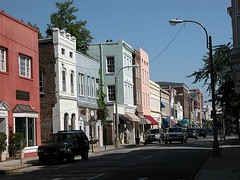A commercial gentrification comment
 King Street, Charleston. Photo from Smugmug Gallery. © Art Hill, www.windycityart.com. Used by permission.
King Street, Charleston. Photo from Smugmug Gallery. © Art Hill, www.windycityart.com. Used by permission.From Caroline Dover, a commercial district revitalization specialist in the South:
When I think of gentrification, I think of Charleston, SC. It's a case story and half. A success story in its own right but to what end? The traditional shopping district being on King Street, but with the advent of Charleston Place Hotel in the 1980s, the whole face was changed. It was a good change at least in the beginning, but now the area is populated with Abercrombies, Gaps, and Banana Republics. The rent is sky high, and there isn't much room for innovation.
However, I have to say that Upper King Street has been reborn as a effect of the gentrification. High rents drove home-grown entrepreneurs to the upper end. Now there is everything from a comic books store, clothing, restaurants, antiques, and home decorating. So that would be a good result of gentrification--being able to offer the shopper the best of both worlds.
However, I would interested to know, how many people make it from the chain end to the home grown end. I've always wondered the feasibility of placing a cap on rents so that an area is able to retain its uniqueness--sort of like rent control apartments in NYC. There has always been a faction of people that have complained about the revitalization of Upper King. The area lost many of its African-American centered businesses, but also filled in many empty buildings. Perhaps a win-lose situation? Gentrification is definitely a multi-layered situation, and unique to every community, in my opinion.



0 Comments:
Post a Comment
<< Home